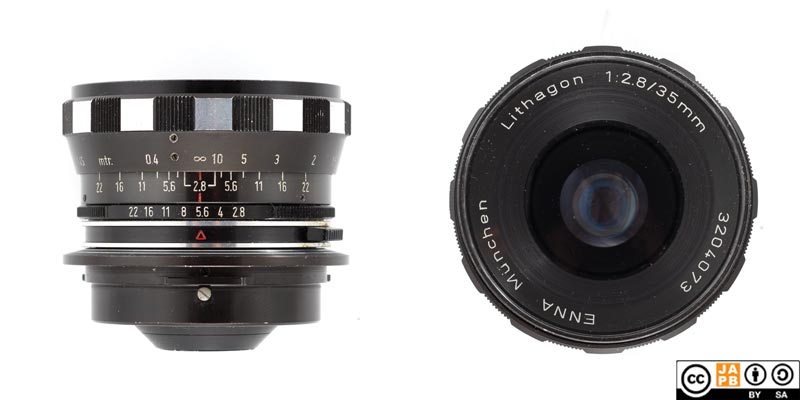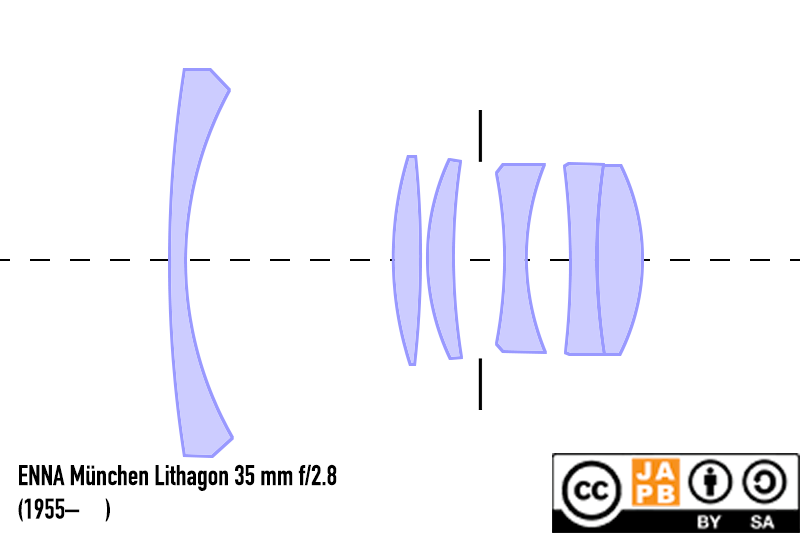Pekka Buttler, 02/2025

Specifications
The table below summarizes the lens’ key specifications (measurements based on pictured version of the lens):
| Brand: | ENNA München | Lens name | Lithagon 1:2,8/35mm |
| Focal length(s)1 | 35 mm | Angle-of-view2 | ≈64 ° |
| Maximum Aperture | f/2.8 | In Production | 1955– |
| Lens mount (this lens) | Praktina | Other lens mounts | M42, Exakta, Enna Sockel |
| Length3 | 35,5 mm | Diameter4 | 58,0 mm |
| Filter ring diameter | 52 mm | Weight | 207 grams |
| Lens element count | 6 | Lens group count | 5 |
| Aperture blades (S/R/C)5 | 7 S | Focus throw | 340 ° |
| Minimum focusing distance (measured) | 41 cms | Maximum magnification (measured) | 1:8,5 |
| Has manual aperture ring | YES | Has Manual focus ring | YES |
| Aperture mechanism type | Preset with stops at full aperture | Aperture click stops | None. |
Further notes:
• This lens was originally introduced in 1955. In the coming decades the same 6 elements in 5 groups design would remain unchanged in all the subsequent 35 mm f/2.8 ENNA lenses.

• This sample is a Preset lens, as were most of the early 35 mm Lithagons.
• Looking at the lens above, the control surfaces/rings of the lens (from camera to filter thread) are: mount; preset ring (including preset change button), aperture ring, depth-of-field indicators, focus ring, front of barrel with filter threads.
• A trait that is likely specific to this Praktina mount variant is that the rearmost lens protrudes a fair bit into the mount (see above), and that the rearmost lens element therefore is relatively exposed. A significant share of Praktina samples show some wear in the centre of the rearmost lens element.
• All early samples of the 35 mm f/2.8 Lithagon are single coated, but there are also later, multicoated versions.
• For most of the lifespan of the 35 mm f/2.8 Lithagon, ENNA München also offered a slower version of the lens in the 35 mm f/3.5 Lithagon. The f/3.5 version can look surprisingly similar but is both slower and based on a clearly less ambitious 4 elements in 4 groups design.
Versions and variations
ENNA München’s family of 35 mm wide-angle lenses was both commercially successful and groundbreaking.
• Lithagon 35 mm f/4.5 – West Germany’s first retrofocus SLR lens (1952)
• Lithagon 35 mm f/3.5 – an upgrade that cemented the Lithagon’s position (1953)
• Super-Lithagon 35 mm f/2.5 – a fast 35 mm lens (1956)
• Super-Lithagon 35 mm f/1.9 – the world’s fastest 35 mm lens, for many years to come (1958)
Roughly in 1955 ENNA München introduced the 35 mm f/2.8 Lithagon (this lens). During the coming years ENNA offered this lens in many mounts (including Enna Sockel, Exakta, M42 and Praktina) and in many cosmetic designs: Broad Zebra [pictured], Silver/Chrome, Narrow Zebra, and All-black.
History of ENNA München
ENNA München (also: Enna Werk München) is one of the 1950s and 60s most prominent and innovative German optics companies. ENNA is especially well-known for being the West-German pioneer in developing retrofocus wide-angle lenses (such as the Lithagon here).
You can read more details in the ENNA München company profile.
Adapting the ENNA München Lithagon 35 mm f/2.8
Obviously, a crucial question is which mount your copy of the Lithagon has. Once you have determined that, see below:
Adapting Enna Sockel Lenses
The Enna Sockel is not strictly speaking a lens mount, but is instead an intermediate mount. This means that if you have managed to procure an Enna Sockel mount lens without the Enna Sockel adapter, your best bet is to head to your preferred online classified’s or marketplace and procure an Enna Sockel to whatever lens mount you already have an adapter for (Personally I think the Sockel-to-M42 adapter is most tempting, but it also usually the most expensive).
Adapting Exakta mount lenses
Exakta mount lenses cannot be used natively on any current SLR or dSLRs. To use it in its native environment, you will need an Exakta-mount film body. Exakta bodies were manufactured in large numbers, but many of them are no longer in a good shape. That said, procuring a workable sample should not be impossible or especially expensive.
Thanks to being a fully manual lens (manual aperture, manual focus), the lens can be adapted to all mirrorless cameras using a suitable adapter. Moreover, the Exakta lenses are so uncomplicated that a simple ‘dumb adapter’ will do the job perfectly. Furthermore, due to the popularity of the Exakta mount, special adapters (helicoid adapters, tilt/shift adapters) are readily available. Alternatively, one can choose to daisy-chain adapters (e.g. Exakta->Canon EF; Canon EF –> mirrorless) which also opens up a wide range of speed boosters .
Using Exakta lenses on dSLRs can also be an easy option, depending on which dSLR.
• Canon EF has the shortest flange focal distance among full-frame dSLR’s and Canon’s wide range of dSLRs are able to mount Exakta lenses perfectly using a simple adapter ring.
• Nikon F, Pentax K and Minolta / Sony A dSLRs need an adapter that uses corrective optics for Exakta lenses (the difference in flange focal distances is not enough to enable reaching infinity focus without corrective optics).
Adapting M42 mount lenses
If you want to natively mount an M42 lens you need to find a functioning M42 mount film camera. Luckily that should be relatively easy as M42 bodies were produced in their millions and most of them lack features that are especially likely to have deteriorated to the point of making the entire camera inoperable. If your sample of the ENNA München Lithagon offers a switch to choose between auto- and manual aperture, I recommend using the lens on a body that is capable of stopping down the lens automatically and offers stop-down metering.
Adapting this lens to a mirrorless, full-frame digital camera is a breeze thanks to the lens having full manual controls (aperture ring, focus ring). You simply need a dumb adapter from M42 to your mirrorless system.
Due to the medium flange focal distance used by the M42 mount (45,46 mm), whether you can adapt this lens to dSLR/SLR mounts depends on which dSLR mount: Canon EF, Four Thirds, Minolta/Sony A and Pentax K can mount m42 lenses using a simple adapter ring. Nikon F on the other hand is not as problem-free, and – to retain anything near infinity focus – the adapter will necessitate corrective optics. In all cases, your camera will work only in stop-down metering.
Adapting Praktina mount lenses
There are no fundamental reasons why you could not adapt your Praktina mount lens, but Praktina mount adapters are not exactly 13 a dozen. In fact, they’re outright rare. I’ve (as of autumn 2024) found one specialised adapter manufacturer that offers Praktina-to–mirrorless adapters (and we’re talking intermediate three-figures prices) as well as a couple of cottage industry manufacturers that sell their products over the typical platforms (ebay, et al.).
This is – in 2024 – outright unusual, as there are no real reasons why Praktina mount lenses could not easily and fluently be adapted to mirrorless full-frame cameras (assuming that you have an adapter).
Moreover, even though the Praktina mount technically has a generous flange focal distance, the fact that that distance is computed for a breech-lock mount that was designed to enable lenses to protrude relatively far into the mount makes it very unlikely that Praktina lenses could successfully be adapted to any SLR/dSLR mount.
Hence, unless you have a functioning, original Praktina camera, your best bet is the combination of a cottage industry adapter to your preferred full-frame mirrorless camera mount.
Footnotes
- Focal length is (unless stated otherwise) given in absolute terms, and not in Full-frame equivalent. For an understanding of whether the lens is wide/tele, see ‘Angle-of-view’. ↩︎
- Picture angle is given in degrees (based on manufacturers’ specs) and concerns the diagonal picture angle. Rule of thumb:
> 90 ° ==> Ultra-wide-angle
70–90 ° ==> Wide-angle
50–70 ° ==> Moderate wide-angle
40–50 ° ==> ‘Standard’ or ‘normal’ lens
20–40 ° ==> Short tele lens
10-20 ° ==> Tele lens
5-10 ° ==> Long tele lens
< 5 ° ==> Ultra-tele lens ↩︎ - Length is given from the mount flange to the front of lens at infinity. ↩︎
- Diameter excludes protrusions such as rabbit ears or stop-down levers. ↩︎
- S=straight; R=rounded; C=(almost)circular at all apertures. ↩︎